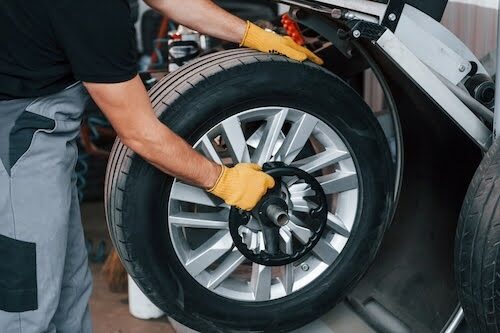Guide to Tire Balancing in Tucson
 In this guide, we’re breaking down everything you need to know about tire balancing, explaining why it matters, how it’s done, and what it means for you. We’ll also tackle the common issues and signs that point to unbalanced tires. Whether you’re a new driver or just looking to extend the life of your tires, this guide has you covered.
In this guide, we’re breaking down everything you need to know about tire balancing, explaining why it matters, how it’s done, and what it means for you. We’ll also tackle the common issues and signs that point to unbalanced tires. Whether you’re a new driver or just looking to extend the life of your tires, this guide has you covered.
What Is Tire Balancing?
Tire balancing is crucial for a smooth driving experience. If you’ve ever felt your steering wheel shake or your car vibrate at certain speeds, chances are, tire imbalance is at play. Let’s dive in and explore what this truly means.
Understanding Tire Imbalance
Every driver should know that tire imbalance isn’t just about having an off-centered tire. It’s more like trying to run with one shoe heavier than the other. When wheels aren’t evenly balanced, the centrifugal forces can cause annoying vibrations. But what causes this imbalance? There are several reasons it can happen, including:
-
- Uneven tire wear: Tires can wear unevenly due to aggressive driving habits or misaligned wheels, contributing to imbalance.
-
- Manufacturing variations: Even new tires can have slightly different weights. Combine this with variations in the wheel, and imbalance occurs.
-
- Tire defects: Occasionally, even brand-new tires might have defects that lead to weight discrepancies.
These seemingly small variations can impact your vehicle’s overall performance, leading to:
-
- Reduced fuel efficiency: More resistance means more energy is used.
-
- Faster tire wear: Imbalanced tires face more stress, wearing out quicker.
-
- Strained suspension components: Your car’s parts are designed to work smoothly — imbalance makes them work harder.
What Does Tire Balancing Do?
Tire balancing is essential for keeping your vehicle running smoothly. Without it, you’ll likely notice a less comfortable ride and more wear on your tires. But what exactly does tire balancing do? Let’s explore how it affects your car’s performance, your tires’ life span, and even your fuel efficiency.
Enhances Vehicle Stability
When your tires are perfectly balanced, your vehicle’s stability improves significantly. Balanced tires help maintain even weight distribution, making your driving experience much smoother and more controlled. Imagine trying to ride a bicycle with one wobbly wheel — it’s awkward and unstable. In a car, imbalanced tires can create a similar feeling, making steering tricky and driving less predictable.
Balanced tires:
-
- Ensure consistent contact with the road.
-
- Reduce vibrations that can lead to handling problems.
-
- Make it easier to steer, especially at higher speeds.
This stability is crucial for safe driving, especially when you encounter changes in road conditions or during sudden stops.
Reduces Uneven Tire Wear
Tire balancing plays a big role in extending the life of your tires. Uneven tire wear is like wearing out one shoe faster than the other; it’s inefficient and eventually leads to replacement. Balanced tires wear down more evenly, which means you’ll be able to keep them for longer.
A few benefits include:
-
- Ensuring your tires wear out at a similar rate due to even tread wear.
-
- Avoiding the extra costs associated with replacing prematurely worn tires.
-
- Decreasing the chances of tire damage from uneven stress.
By having a professional balance your tires regularly, you’re ensuring they stay in top condition, saving money in the long run.
Improves Fuel Efficiency
Did you know that tire balancing can actually help you save on gas? When your tires are balanced, your car doesn’t have to work as hard to maintain speed. This means it uses less fuel, just as a well-tuned bike needs less energy to pedal uphill.
Consider these points:
-
- Balanced tires roll more efficiently, reducing drag.
-
- Less energy required for steering means reduced fuel consumption.
-
- Proper balance helps maintain optimal vehicle alignment.
These improvements translate to more miles per gallon, which is great for both your wallet and the environment. Tire balancing can help you cut costs on both daily commutes and long road trips.
Why You Need Tire Balancing Service
When it comes to smooth driving, tire balancing is a must-have service. Your vehicle’s tires are as vital as its engine or brakes. While you might not realize it, tire balancing keeps your ride smooth and your car’s systems in peak condition. Some ask, “Is it really important?” The answer is a resounding yes!

Unlike tire alignment, which typically deals with the angles of tires, tire balancing ensures that your wheels are spinning evenly. This evens out any weight discrepancies in the tire and wheel assembly. Skipping regular tire balancing can create an extremely uneven driving experience, similar to driving on a rough road.
Signs Your Tires Need Balancing
Do you ever feel like your vehicle is trying to tell you something? If it’s giving off little shakes or noises, it’s likely your tires are speaking up. Here’s a list of some signs you don’t want to ignore:
-
- Vibrations while driving: Unexplained vibrations in the steering wheel, seat, or floorboard are common indicators.
-
- Uneven tire wear: When one part of the tire is far more worn down, it might be a sign of imbalance.
-
- Funny noises: Unusual noises such as humming or thumping sounds can indicate an imbalance issue.
-
- Poor fuel economy: If your car’s using more gas than usual, unbalanced tires might be the sneaky culprit.
-
- Steering issues: Difficulty in steering straight or veering to one side, even on a straight road, might hint at imbalance.
Ignoring these signs can wear out your tires prematurely, leading to much more costly repairs.
Recommended Balancing Frequency
So how often should you be balancing your tires? Think about tire balancing service as a regular health checkup for your car. Our expert mechanics recommend doing it every 5,000-7,000 miles or whenever you notice any of the signs above. Here are some other specific times it should be done:
-
- Whenever you change tires: New tires should always be balanced to ensure even wear from the start.
-
- After pothole encounters: If you’ve hit an unexpected giant pothole, checking the balance might save you future trouble.
-
- During every tire rotation: Many people misunderstand balancing with rotation, but they’re different — and should go hand in hand.
Regular balancing can dramatically improve ride comfort and extend the life of your tires. With this service, your car feels better on the road, and so do you, knowing your tires are properly cared for.
By keeping up with tire balancing service, you’ll be helping make every trip smooth, safe, and economical.
Types of Tire Balancing
Now that we understand why tire balancing is essential, let’s look at different methods utilized:
Static Balancing
Think of static balancing like placing a marble in the exact middle of a hula hoop without rolling it out. In this method, a single spot on the wheel is adjusted to make it rest evenly when not in motion.
- Pros:
- Simpler process: generally requires less equipment.
- Great for certain tires: particularly useful for narrower motorbike tires.
- Cons:
- Less effective: doesn’t address the dynamic nature of tire imbalance.
Dynamic Balancing
To ensure smooth and stable driving, dynamic balancing addresses both lateral and vertical imbalances that may be present.
- Pros:
- Comprehensive: offers more accurate balance, as it considers all forces acting on a tire.
- Versatile: works well for almost all vehicle types.
- Cons:
- More time-consuming: often needs more specialized equipment.
Different situations often require different tire balancing methods. No matter which one your mechanic uses, the key is ensuring that every part of your tire moves in perfect harmony with your vehicle.
How Is Tire Balancing Performed?
Tire balancing is like fine-tuning an instrument; it makes sure your ride is smooth, not bumpy. If your car starts vibrating at certain speeds, tire imbalance is often part of the cause.
But how exactly do mechanics fix this? Let’s explore the tools they use and each step involved in the balancing process.
Tools and Equipment Used
Balancing tires isn’t just about eyeballing what seems off and making adjustments based on educated guesses. Professional mechanics use specific tools to get vehicles rolling smoothly again. The essential tools used include:
-
- Wheel balancer: This is the cornerstone of tire balancing. It spins the tire and wheel to identify any imbalances.
-
- Tire weights: These are small counterbalancing weights added to offset the uneven distribution in a tire.
-
- Tire changer: While not specifically for balancing, this tool helps remove or mount tires onto wheels.
-
- Tire pressure gauge: This makes sure the tire is inflated to its correct pressure, as incorrect inflation can affect the balance.
-
- Lift or jack: This lifts the vehicle so the tires can be removed easily.
The tools used for tire balancing all work together to ensure that your tires are in perfect weight balance.
Step-by-Step Tire Balancing Process
Balancing tires involves a few key steps that your mechanic will follow in precise order:
-
- Lift and remove: They will start by lifting the vehicle and removing the wheels.
-
- Inspect and clean: They inspect the tire for debris or wear and clean the wheel. Dirt can throw off measurements, much like adding an extra ingredient can ruin a cake.
-
- Spin and detect: Using a wheel balancer, mechanics spin the tire to detect imbalances. The machine will often display results — a handy digital guide indicating where the tire is heavier.
-
- Attach weights: After finding the imbalance, they attach small lead or steel weights to the lighter side of the wheel. This is like adjusting scale weights for perfect balance.
-
- Respin to confirm: Once weights are applied, they spin the tire again to check the balance. If needed, adjustments are made.
-
- Reinstall the tire: Lastly, the balanced tire is reattached to the vehicle with the correct torque applied to the lug nuts, ensuring everything’s tight and secure.
When done right, tire balancing enhances tire life, improves ride comfort, and provides a safer driving experience. It’s worth asking: When was the last time you had your tires balanced? Keeping this in mind can make a big difference in your driving routine.
Tire Balancing Is a Crucial Part of Proper Vehicle Maintenance
Tire balancing might seem like an aspect of car maintenance that is easy to overlook, but it’s a crucial component of maintaining a safe and comfortable driving experience. Proper tire balancing helps to ensure a smoother ride by reducing vibrations and improving vehicle handling.
By distributing weight evenly across the tire, balancing also helps to prevent uneven wear, prolonging the life of your tires and improving fuel efficiency, saving you money in the long run. So while tire balancing may seem like a small detail, it’s an essential step in ensuring that your vehicle is performing at its best and keeping you safe on the road.
You can trust BRAKEmax Tire & Service Centers when you need tire balancing in Tucson to keep your vehicle running smoothly. From routine maintenance to major repairs, our expert team has you covered.